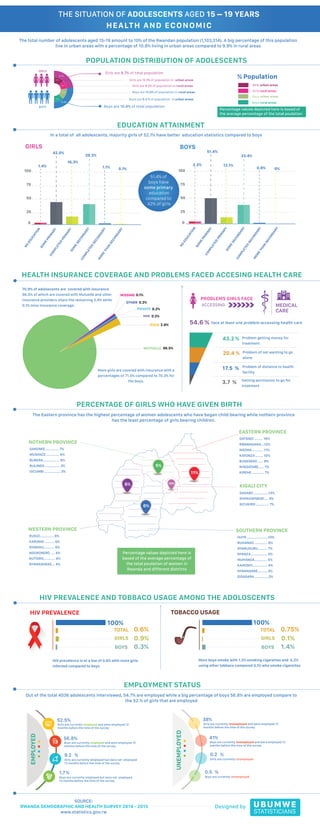
Situation and Health of Rwandan Adolescents Aged 15-19
- 1. THE SITUATION OF ADOLESCENTS AGED 15 – 19 YEARS HEALTH AND ECONOMIC The total number of adolescents aged 15-19 amount to 10% of the Rwandan population (1,103,314). A big percentage of this population live in urban areas with a percentage of 10.8% living in urban areas compared to 9.9% in rural areas POPULATION DISTRIBUTION OF ADOLESCENTS EDUCATION ATTAINMENT Girls are 9.7% of total population Boys are 10.4% of total population Girls are 12.1% of population in urban areas Boys are 9.4 % of population in urban areas Girls are 9.2% of population in rural areas Boys are 10.6% of population in rural areas 10.4% 9.7% 12.1% 9.2% 10.6% 9.4% BOYS GIRLS 1.4% 42.0% 16.3% 39.2% 1.1% 0.1% NO EDUCATION NO EDUCATION SOMEPRIMARY SOMEPRIMARY SOMESECONDARY SOMESECONDARY MORETHAN SECONDARY MORETHAN SECONDARY COMPLETED SECONDARY COMPLETED SECONDARY COMPLETED PRIMARY COMPLETED PRIMARY NO EDUCATION NO EDUCATION SOMEPRIMARY SOMEPRIMARY SOMESECONDARY SOMESECONDARY MORETHAN SECONDARY MORETHAN SECONDARY COMPLETED SECONDARY COMPLETED SECONDARY COMPLETED PRIMARY COMPLETED PRIMARY 0 25 50 75 100 2.2% 51.4% 12.1% 33.4% 0.9% 0% 0 25 50 75 100 In a total of all adolescents, majority girls of 52.1% have better education statistics compared to boys 51.4% of boys have some primary education compared to 42% of girls HEALTH INSURANCE COVERAGE AND PROBLEMS FACED ACCESING HEALTH CARE PERCENTAGE OF GIRLS WHO HAVE GIVEN BIRTH RSSB 96.5% 2.8% 0.2% 0.2% 0.2% 0.1% MMI PRIVATE OTHER MISSING MUTUELLE 70.9% of adoloscents are covered with insurance 96.5% of which are covered with Mutuelle and other insurance providers share the remaining 3.4% while 0.1% miss insurance coverage. More girls are covered with insurance with a percentages of 71.5% compared to 70.3% for the boys. Percentage values depicted here is based of the average percentage of the total poulation of women in Rwanda and different districts 11% 11% 5% 6% 6% 10% EASTERN PROVINCE GATSIBO ........ 16% RWAMAGANA...12% NGOMA .......... 11% KAYONZA ....... 10% BUGESERA ..... 9% NYAGATARE..... 7% KIREHE ........... 7% WESTERN PROVINCE RUSIZI............. 8% KARONGI ......... 6% NYABIHU.......... 6% NGORORERO .... 6% RUTSIRO........... 4% NYAMASHEKE... 4% NOTHERN PROVINCE GAKENKE............. 7% MUSANZE ............ 6% BURERA............ ... 6% RULINDO .............. 3% GICUMBI ............... 3% SOUTHERN PROVINCE HUYE ....................10% RUHANGO ............ 8% NYARUGURU ........ 7% NYANZA ............... 5% MUHANGA............ 5% KAMONYI.............. 4% NYAMAGABE......... 4% GISAGARA .............3% KIGALI CITY GASABO ..............13% NYARUGENEGE.... 9% KICUKIRO ............ 7% The Eastern province has the highest percentage of women adolescents who have began child bearing while nothern province has the least percentage of girls bearing children. Out of the total 4036 adolescents interviewed, 54.7% are employed while a big percentage of boys 56.8% are employed compare to the 52.% of girls that are employed 0.6% 0.9% 0.3% TOTAL GIRLS BOYS HIV PREVALENCE AND TOBBACO USAGE AMONG THE ADOLOSCENTS EMPLOYMENT STATUS 0.75% 100%100% 0.1% 1.4% TOTAL GIRLS BOYS More boys smoke with 1.2% smoking cigarettes and 0.2% using other tobbaco compared 0.1% who smoke cigarettes Girls are currently employed and were employed 12 months before the time of the survey 52.5% Girls are currently employed but were not employed 12 months before the time of the survey 9.2 % Boys are currently employed but were not employed 12 months before the time of the survey 1.7% Boys are currently employed and were employed 12 months before the time of the survey 56.8% Girls are currently Unemployed and were employed 12 months before the time of the survey 38% Girls are currently Unemployed 0.2 % Boys are currently Umemployed 0.5 % Boys are currently Unemployed and were employed 12 months before the time of the survey 41% BOYSGIRLS SOURCE: RWANDA DEMOGRAPHIC AND HEALTH SURVEY 2014 - 2015 www.statistics.gov.rw Girls urban areas Girls rural areas Boys urban areas Boys rural areas % Population HIV PREVALENCE TOBACCO USAGE UBUMWE STATISTICIANS Designed by Percentage values depicted here is based of the average percentage of the total poulation MEDICAL CARE ACCESSING Getting permission to go for treatment Problem getting money for treatment Problem of distance to health facility Problem of not wanting to go alone face at least one problem accessing health care54.6 % 43.2 % 20.4 % 17.5 % 3.7 % PROBLEMS GIRLS FACE HIV prevalence is at a low of 0.6% with more girls infected compared to boys